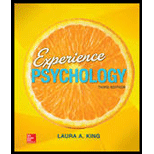
Correct answer:
The correct answer in this case is option (B), discriminates between different groups.
Explanation of Solution
Reason for the correct statement:
An empirically keyed test asks the same questions to two different groups that are known to be different. The test items are not related to what the researchers are studying. Therefore, by doing this, personality researchers can overcome the problem of social desirability in self-report testing.
Reasons for the incorrect statements:
Option (A) refers to empirically keyed tests having right or wrong answers. By nature, self-report tests have no right or wrong answers. These tests simply describe a person’s preferences. So, option (A) is incorrect.
Option (C) refers to empirically keyed tests having face validity. Empirically keyed tests do not relate to the research question on the surface, so they don’t have face validity. So, option (C) is incorrect.
Option (D) refers to empirically keyed tests having both easy and difficult questions. Since self-report tests are merely asking respondents to share details about themselves, all questions should be fairly simple to answer. So, option (D) is incorrect.
Therefore, the options (A), (C), and (D) are incorrect.
Personality researchers use empirically keyed tests to help distinguish between two groups that are known to be different. Using this technique helps them overcome the issue of social desirability that occurs with self-report tests.
Want to see more full solutions like this?
Chapter 10 Solutions
Loose Leaf Experience Psychology - Standalone Book
- Identify applicable scenarios and examples observed ‘in action’ during your class behavior. Provide an analysis of psychological theory, themes, and concepts evident in the work observed during class. What theoretical framework is used to understand/explain what occurred in your experiences?arrow_forwardwhat makes the candomble tradition stand out?arrow_forwardby observing behavior students in class , what your thoughts about the effectiveness and purpose of the work being done there?arrow_forward
- When would using checklists and rating scales be most appropriate in early childhood? Use scholarly sources.arrow_forwardI need help with two articles are there any similarities and differences between the two https://www.phnompenhpost.com/business/indian-ambassador-pledges-increased-trade-tourismpromotion, https://time.com/5486460/pol-pot-cambodia-1979/arrow_forwardEvaluate the application of behaviourism and cognitive psychological perspectives to contemporary issues in psychology.arrow_forward
- Analyse the similarities and the differences between behaviourism and cogniperspectives in psychology.arrow_forwardEvaluate the work of key theorists Neisser, 1967 relating to congnitive psychological perspectivearrow_forwardEvaluate the work of key theorists John B. Watson and B.F. Skinner relating to behaviourismarrow_forward
 Ciccarelli: Psychology_5 (5th Edition)PsychologyISBN:9780134477961Author:Saundra K. Ciccarelli, J. Noland WhitePublisher:PEARSON
Ciccarelli: Psychology_5 (5th Edition)PsychologyISBN:9780134477961Author:Saundra K. Ciccarelli, J. Noland WhitePublisher:PEARSON Cognitive PsychologyPsychologyISBN:9781337408271Author:Goldstein, E. Bruce.Publisher:Cengage Learning,
Cognitive PsychologyPsychologyISBN:9781337408271Author:Goldstein, E. Bruce.Publisher:Cengage Learning, Introduction to Psychology: Gateways to Mind and ...PsychologyISBN:9781337565691Author:Dennis Coon, John O. Mitterer, Tanya S. MartiniPublisher:Cengage Learning
Introduction to Psychology: Gateways to Mind and ...PsychologyISBN:9781337565691Author:Dennis Coon, John O. Mitterer, Tanya S. MartiniPublisher:Cengage Learning Psychology in Your Life (Second Edition)PsychologyISBN:9780393265156Author:Sarah Grison, Michael GazzanigaPublisher:W. W. Norton & Company
Psychology in Your Life (Second Edition)PsychologyISBN:9780393265156Author:Sarah Grison, Michael GazzanigaPublisher:W. W. Norton & Company Cognitive Psychology: Connecting Mind, Research a...PsychologyISBN:9781285763880Author:E. Bruce GoldsteinPublisher:Cengage Learning
Cognitive Psychology: Connecting Mind, Research a...PsychologyISBN:9781285763880Author:E. Bruce GoldsteinPublisher:Cengage Learning Theories of Personality (MindTap Course List)PsychologyISBN:9781305652958Author:Duane P. Schultz, Sydney Ellen SchultzPublisher:Cengage Learning
Theories of Personality (MindTap Course List)PsychologyISBN:9781305652958Author:Duane P. Schultz, Sydney Ellen SchultzPublisher:Cengage Learning





